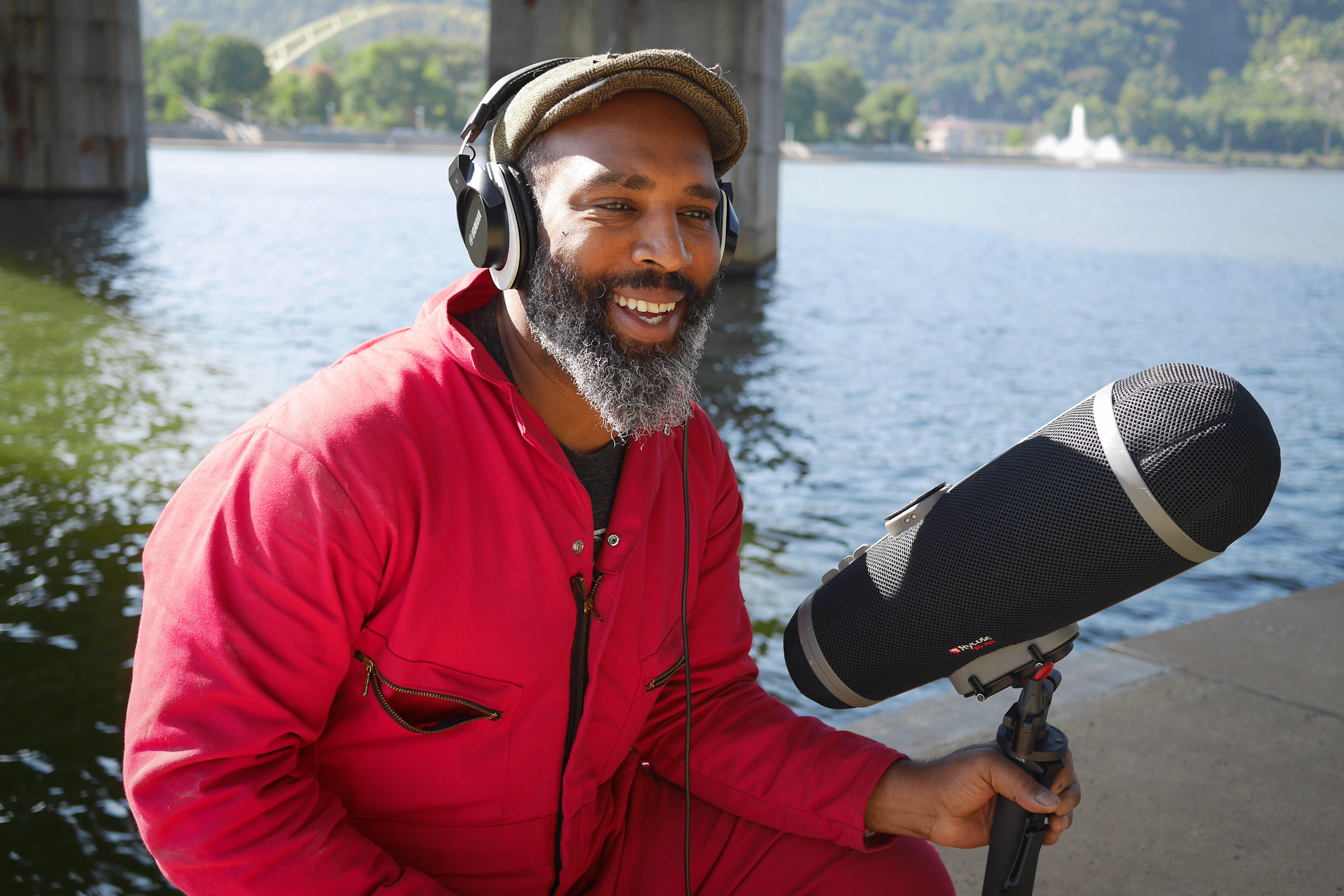This story originally aired October 7, 2016
Along the North Shore of the Allegheny River in Pittsburgh, the sounds of bicycle chains and the whoosh of wheels from a nearby trail mix with the roar of cars crossing the river’s many bridges. But what does it sound like under the water? That’s what I’m here to find out. It’s mid-morning and the last of the early autumn fog is lifting.
“We picked a beautiful day to go sound fishing.” That’s how I’m greeted by Ricardo Iamuuri Robinson, a field recordist, composer and artist. He wears a lot of hats. Actually, today he’s sporting a red jumpsuit, like the ones auto mechanics wear. He calls it his “supersonic uniform.”
LISTEN TO THE AUDIO VERSION OF THIS STORY
We’re meeting at the edge of the water under the Fort Duquesne Bridge. Robinson has promised we’re going to throw a hydrophone—a mic designed to withstand water—into the Allegheny River and see what we can pick up.
He pulls a rolled up, yellow cord out of his bag, and at the end is a small disk. It’s the hydrophone. “I like the architecture on this one,” he says. “Kind of looks like a stethoscope.”
He lowers it in with a splash, then threads the cable through his fingers. He turns on the sound mixer and recorder it’s plugged into, puts headphones over his ears and listens.
“It’s pretty crazy,” he tells me. “What’s interesting about the majority of the hydrophone recordings that I’ve done in rivers is I’ve wanted to hear something more gargle-y. But what I hear most often are metallic noises. They’re very ting-tingy.”
LISTEN: What it Sounds Like Beneath Pittsburgh’s Three Rivers
Robinson collects sounds like these for his library. They could be used one day in films, video games or art installations. He also works as a Foley artist—someone who recreates everyday sounds like creaking doors or walking in the snow.
On the riverbank, he gets down on his stomach, flush with the concrete, and jiggles the line to make sure it’s not caught on any floating trash or driftwood. He really does look like he’s fishing. Then he sets up the shotgun mic and points it into the air. It’s the size of a small cat and looks like a giant pill capsule. With it he can hear what’s happening above ground as well as below the water.
“It just changed everything,” he says. “I’m really excited at this moment. It’s rhythmic.”
This layering of sounds is key to a project he’s working on now: finding places throughout Pittsburgh that hold historical interest to him and creating audio tours designed for those specific spaces. He’s putting the finishing touches on a tour of the bustling Strip District neighborhood, complete with a spoken narrative. He has another planned for the Roberto Clemente Bridge.
“I’m really interested in what I would call the sonic evolution of space,” he says. “What it once sounded like before industry and technology arrived, what it presently sounds like and what it will someday sound like. It’s just very interesting to me that with development and this thing we call progress, also comes a soundtrack.”
“I’m really interested in what I would call the sonic evolution of space: What it once sounded like before industry and technology arrived, what it presently sounds like and what it will someday sound like. It’s just very interesting to me that with development and this thing we call progress, also comes a soundtrack.”
He calls it “sonarcheology”—sound archeology. It’s the name of his business, art form—and really part of his identity. He says it all started about two years ago. His background is addressing social issues through writing and performing music. But it was hard, singing about the same old problems—like war and injustice—over and over.
“Somewhere along the way, my lyrics also became just another sound in the soundscape,” he says. “It humbled me.”
That’s when he started making field recordings, like this one of the Allegheny River.
“Just like us, it kind of lives and speaks its own language and changes, and I love that. I love documenting that.”
So just what are we capturing today? Robinson lets me slip on his headphones and experience it for myself. For me, the overall effect is reminiscent of a huge bathtub. I get a feel for how big the river really is. There are waves, clicks and clacks. It sounds like another world.
“I think you’re absolutely right,” Robinson says. “When I put on my headphones, it’s my peace of mind. And it’s meditative. I can just sit here for a while and just listen to that sort of symphony.”
###
The Sonarcheology Pittsburgh project is supported in part by The Heinz Endowments and The Pittsburgh Foundation, which also support The Allegheny Front.

